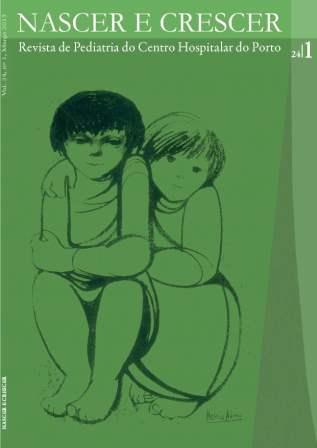Safe sleep environment in first year of life
DOI:
https://doi.org/10.25753/BirthGrowthMJ.v24.i1.8573Keywords:
Infant, safe sleep, sudden infant death syndromeAbstract
Background: Most of anticipatory care to promoting a safe sleep environment is related to the prevention of Sudden Infant Death Syndrome. Nowadays, it is unknown if the recommended preventive measures are followed by parents.
Objectives: Characterize maternal behaviours to promoting of a safe sleep environment during the first year of life.
Material and Methods: An observational, descriptive, cross-sectional study was conducted with a convenience sample consisting of mothers whose children have ! 12 months, with medical appointment between 01.09.2012 and 30.12.2012. Data were collected using an anonymous selffulfilment questionnaire realized by the mothers and then it was performed a descriptive statistical analysis.
Results: 89 questionnaires were validated; 38.2% of the inquired mothers prefer the recommended supine position for placing their infant for sleep; 75.0% from the 58.4% that elect side positioning did so because they believed to be the safest position; 89.9% of infants slept in the same room as their parents; 68.5% of the inquired mothers said they had fallen asleep with the child in his bed at least once and the major reasons for bed sharing were: to calm a fussy infant (60.7%) and / or facilitate breastfeeding (31.1%).
Discussion/Conclusion: Despite study limitations, there was evidence of low compliance to the current recommendations related to promoting a safe sleep environment. Therefore, it is important that health professionals ensure that parents understand the risks and benefits of their practices.
Downloads
References
Direção Geral da Saúde. Programa Nacional de Saúde Infantil e Juvenil. Norma 010/2013; 2013. Disponível em: http://www.dgs.pt/ [acedido em 06/10/2013].
Hauck FR, Tanabe KO. International Trends in Sudden Infant Death Syndrome: Stabilization of Rates Requires Further Action. Pediatrics 2008; 122:660-6.
Task Force on Sudden Death Syndrome. The Changing Concept of Sudden Infant Death Syndrome: Coding Shifts, Controversies Regarding the Sleeping Environment, and New Variables to Consider in Reducing Risk. Pediatrics 2005; 116:1245-55.
Hunt CE, Hauck FR. Sudden Infant Death Syndrome. CMAJ 2006; 174:1861-9.
Adams SM, Good MW, DeFranco GM. Sudden Infant Death Syndrome. American Family Physician 2009; 79:870-4.
Ostfeld BM, Esposito L, Perl H, Hegyi T. Concurrent Risks in Sudden Infant Death Syndrome. Pediatrics 2010; 125:447-53.
SIDS and Other Sleep-Related Infant Deaths: Expansion of Recommendations for Safe Infant Sleeping Environment. Pediatrics 2011; 128:1030-9.
Sociedade Portuguesa de Pediatria (SPP) e Secção de Neonatologia da SPP. Como reduzir o risco de Síndrome da Morte Súbita do Latente. 2009. Disponível em: http://www.spp.pt/ [acedido em 06/04/2012].
DGS. Boletim de Saúde Infantil e Juvenil. Disponível em: http://www.dgs.pt/ [acedido em 06/10/2013].
Remoaldo PCA. Comportamentos preventivos dos pais relacionados com o Síndrome de Morte Súbita do Lactente. Saúde Infantil 2000; 22:19-22.
Ferreira MC, Gomes A, Pinto E, Marques R. Síndrome da morte súbita do lactente. Estaremos mesmo a prevenir? Saúde Infantil 2004; 26:13-22.
Monn RY, Omron R. Determinants of infant sleep positioning in na urban population. Clin Pediatr (Phila) 2002; 41:569-73.
Hauck FR, Signore C, Fein SB, Raju TNK. Infant sleeping arrangements and practices during the first year of life. Pediatrics 2008; 122:S113-20.
Fernandes A, Fernandes CA, Amador A, Guimarães F. Síndrome da morte súbita do lactente: o que sabem os pais?. Acta Pediatr Port 2012; 43:59-62.
Downloads
Published
How to Cite
Issue
Section
License
Copyright and Authors' Rights
All articles published in Nascer e Crescer - Birth and Growth Medical Journal are Open Access and comply with the requirements of funding agencies or academic institutions. For use by third parties, Nascer e Crescer - Birth and Growth Medical Journal adheres to the terms of the Creative Commons License "Attribution - Non-Commercial Use (CC-BY-NC)".
It is the author's responsibility to obtain permission to reproduce figures, tables, etc. from other publications.
Authors must submit a Conflict of Interest statement and an Authorship Form with the submission of the article. An e-mail will be sent to the corresponding author confirming receipt of the manuscript.
Authors are permitted to make their articles available in repositories at their home institutions, provided that they always indicate where the articles were published and adhere to the terms of the Creative Commons license.


